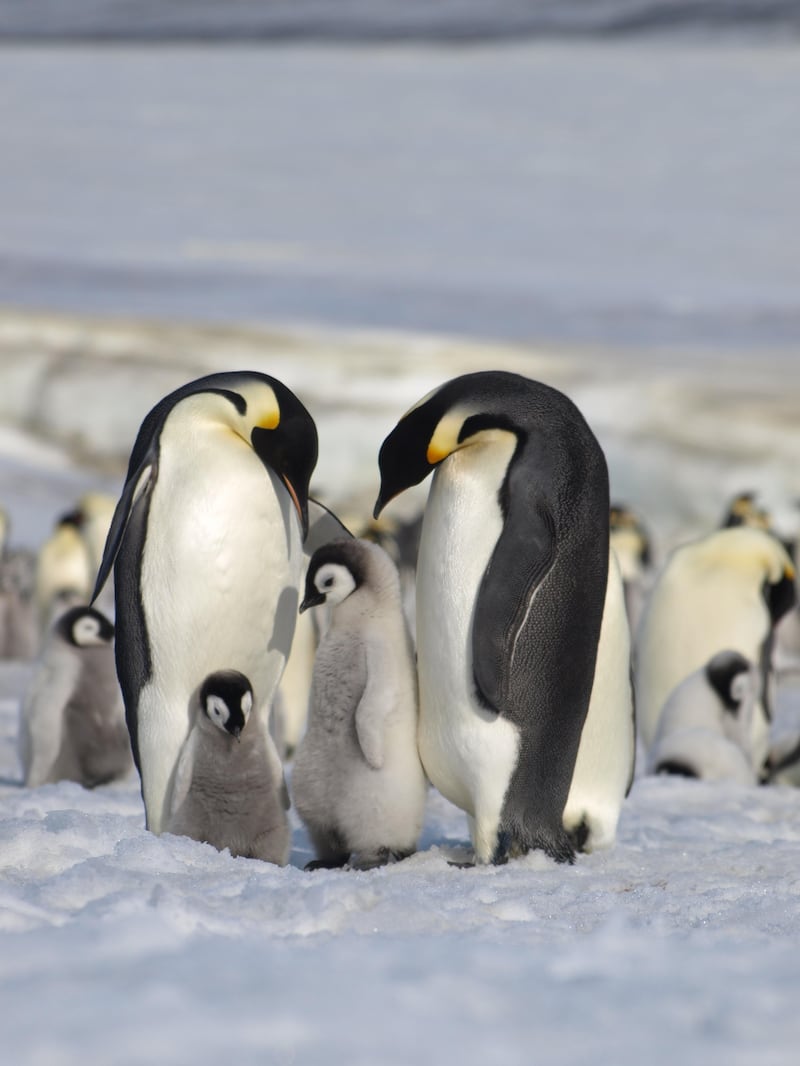Thousands of emperor penguin chicks across four colonies in Antarctica likely died because of record-low sea ice levels that caused a “catastrophic breeding failure” in late 2022, according to new research.
Analysis of satellite images showed the break-up of usually stable sea ice and the disappearance of the colonies at a time when chicks had not yet grown their waterproof feathers.
Scientists have said emperor penguins face an uncertain future under global heating because they are so reliant on sea ice, which is projected to decline as the world’s oceans heat up.
The breeding failures in the Bellingshausen Sea were “without precedent”, the research said, as it was the first time multiple colonies across a large region had all failed in a single season.
READ MORE
Grim story
“It’s a grim story,” said Dr Peter Fretwell, a researcher with the British Antarctic Survey and the lead author of the research. “I was shocked. It’s very hard to think of these cute fluffy chicks dying in large numbers.
“We had predicted it for a long time. The sea ice loss has been unprecedented and far quicker than we imagined.”
Antarctic sea ice shrunk to a record low in February, which followed a record low the year before, in events that have shocked scientists.
Large patches of brown guano – a buildup of excrement – on the white sea ice make emperor penguin colonies visible from satellites.

The study, published in the journal Communications Earth & Environment, observed the sea ice breaking apart from late October to early December at colonies at Verdi Inlet, Smyley Island, Bryant Coast and Pfrogner Point.
Many parts of the region had near total loss of sea ice. Dr Fretwell estimated as many as 7,000 chicks may have perished.
“In some cases it’s possible the sea broke up into smaller flows or under the feet of the penguins,” he said.
“If they get immersed, the chicks will drown. If they get back on to the ice flows, they will freeze because they don’t have their waterproof feathers at that stage.”
Some breeding was possibly successful at one colony in the region, at Rothschild Island, because icebergs may have helped to stabilise the ice, giving the chicks the chance to fledge.
During a previously recorded breeding failure at a large colony in the Weddell Sea, Dr Fretwell said adults had likely moved to another colony less than 100km away.
“That’s why this regional failure is so difficult [for the penguins] because they can’t just go to the nearest colony,” he said.
“A 1,500km region in length has lost almost all its sea ice. We have no real idea what happens if there’s no ice.”
About 30 per cent of the known 62 emperor penguin colonies in Antarctica have been affected by partial or total sea ice loss since 2018.
Emperor penguins – featured in the animated Happy Feet films – are unusual in that they have not come under pressure from hunting, fishing or loss of habitat.
Global heating is considered their main long-term threat, with projections that by 2100 about 90 per cent of colonies could be so small that they are essentially extinct.
Dr Barabara Wienecke, a senior research scientist at the Australian Antarctic Division, has made dozens of visits to emperor penguin colonies.
She said the research, which she was not involved in, provided little doubt that thousands of chicks had died.
By October chicks form “creches” while both their parents are out catching fish, she said, but are “nowhere near being waterproof”.
“They still have their downy plumage. If the ice breaks out before they can safely enter the water, the plumage becomes waterlogged and, basically, the chicks die of exposure.
“It’s horrendous and I find it extraordinarily distressing to think of this happening.”
Both Dr Wienecke and Dr Fretwell said projections of the future for the penguin species may have to be revised, with the risk potentially greater than previously feared. - Guardian









